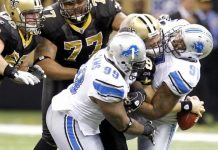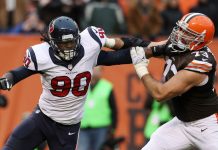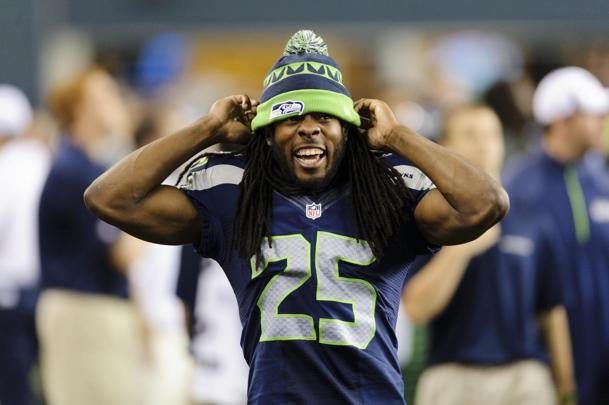FLORHAM PARK, N.J. (AP) Henry Anderson has a tiny red scar in the middle of his neck that’s easy to miss because it’s nearly hidden by a crease in his skin.
The New York Jets defensive lineman knows exactly where it is, though, and it serves as a clear and constant reminder to him of the fluke injury – a fractured larynx – that could have very easily turned out a lot worse.
”I’ve definitely had injury problems, so some dumb injury like that probably would happen to me,” Anderson said after a recent practice.
”But I’m hoping all that stuff is in the past and that I’ll have some good health for a while. So, I’m hoping that’s the last of it.”
Anderson was playing for Indianapolis last Nov. 5, when he rushed Houston’s offensive tackle while trying to make a play – and, then, felt the crushing blow.
”The running back chipped me,” Anderson recalled, ”and his elbow just went into my throat, like the tip of his elbow.”
Anderson didn’t think much of it at first, having taken lots of hits to his throat area throughout his football career. So, he kept playing.
The Colts won 20-14 with Anderson notching three tackles in the game. But as the hours went by, Anderson soon realized something was definitely wrong.
”I don’t know if I can explain the sensation, but it pretty much felt like, not my windpipe but maybe my esophagus felt like it was swollen shut,” Anderson said. ”I was breathing and everything fine, but whenever I tried to eat food or drink water, it felt swollen shut. … It was pretty painful.”
He went through tests and exams, which revealed the laryngeal fracture.
Commonly called the voice box, the larynx is a muscular organ involved in breathing, producing sound and protecting the trachea. If he had been hit there again while playing, he could have died because his air supply could have been stopped.
”I could only really whisper for a few days and couldn’t really eat much food for, I want to say three or four days,” Anderson said.
Doctors realigned the cartilage in his throat and pinned it down, Anderson said. He started feeling better within a few days, and was relieved to know his football career wasn’t over – as he initially feared.
”Yeah, that crossed my mind,” he said.
He also had to get over some initial uneasiness on the field during offseason workouts with the Jets in the spring.
”The first time moving around and going against offensive linemen and stuff, there were a couple of times where I got hit in the throat,” Anderson said, ”and I was kind of feeling around and wiggling it around to make sure everything was good, and it was totally normal. So, I don’t really think about it anymore.”
Anderson is focused only on football now and winning a spot on New York’s defensive line. He has been rotating throughout training camp with rookie Folorunso Fatukasi at defensive end opposite Leonard Williams on the starting unit.
”They’re both very smart, both very strong,” coach Todd Bowles said. ”Obviously, Anderson has played a little more and he has some experience there, so he can go down the line and rotate.”
Anderson, drafted by the Colts in the third round out of Stanford in 2015, had a promising rookie season that included two sacks but he tore a knee ligament midway through. He bounced back and played the following season, and then appeared on his way to a possible breakout year in 2017 before the throat injury.
Anderson played his first three seasons in a 3-4 defensive scheme with the Colts, but they planned to move to a 4-3 base this year.
Defensive ends in 3-4s are usually lined up on the tackle or the guard and take on double teams, but those in 4-3s play a bit more out in space and are typically faster and less bulky.
So, Anderson, who played at 295 pounds last year, started losing weight in the offseason to prepare. But, the Colts ended up trading Anderson to the Jets during the NFL draft in April for a seventh-round pick.
”I don’t know if I was a great fit in that new 4-3 scheme,” he said. ”I’ve been in a 3-4 for eight years, going back to college, so that’s the scheme I’m most comfortable in.”
Bowles and the Jets run a 3-4 base defense, so Anderson needed to bulk up again after dropping about 28 pounds in the offseason.
”I put a lot of pressure on myself to try to gain it back the right way and still eat the right way, and not just sit there eating cheeseburgers and pizza all day,” he said.
”So, I was having to kind of stuff my face with food. There were a few times before practice where I’d try to eat as big a meal as I could, and then we’d come out to practice and I had so much food in my stomach that I wasn’t feeling too good out here.”
When the Jets finished minicamp in June, Anderson went to work with his trainer, who set him up with workout and eating plans that he followed closely over the next several weeks. He reported to training camp at about his regular playing weight of 295.
”It’s been a good change of scenery,” Anderson said. ”It was just a way to kind of just get a fresh start somewhere, get a different set of eyes coaching you, different styles of coaching to teach you different things. I think it’s been really good for me as a player and I’m definitely excited to hopefully continue this for a while.”
—
More AP NFL: https://apnews.com/tag/NFLfootball and https://twitter.com/AP-NFL
25% Bonus via Western Union
















